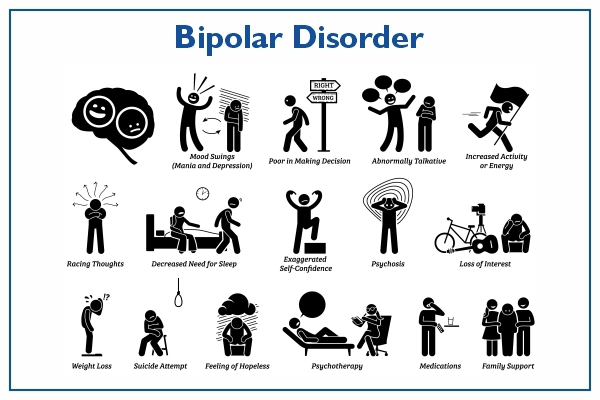Bipolar Disorder : Overview
Bipolar disorder is also known as manic depression which is a kind of mental health illness that involves high emotional feelings (mania or hypomania) and lows (depression).
One may feel extremely sad or hopeless when one is depressed, and may lose interest or pleasure in most activities. Sometimes also feel ecstatic, full of energy, or abnormally irritable when mood switches to mania or hypomania (a milder form of mania). Sleep, energy, activity, judgment, conduct, and the ability to think clearly can all be affected by mood fluctuations.
Mood swings can happen once a year or several times a year. While the majority of people will have some emotional symptoms in between episodes. Here you can find all the types of Bipolar disorders, symptoms, causes, risk factors, diagnosis and treatments in detail.
Secure your health with a second opinion. Make informed decisions and book your appointment today!
Get A Second Opinion
Types of Bipolar Disorder
- Bipolar Disorder 1: Characterized by manic episodes lasting a week or more, with or without depression symptoms. Severe mania may require hospitalization, and depression may persist for over two weeks.
- Bipolar Disorder 2: Features both manic and depressive episodes, with milder mania (hypomania) compared to bipolar 1. A significant depressive episode typically precedes or follows the manic phase.
- Cyclothymic Disorder: Manic and depressive periods lasting two years or more, with milder symptoms than bipolar 1 or 2. Children must experience both for at least a year before diagnosis, exhibiting mood swings and cycles of normalcy, mania, and sadness.
Symptoms of Bipolar Disorder
The symptoms can be different in mania, hypomania, or depression episodes. Symptoms can lead to erratic mood and conduct, causing severe distress and problems in daily life.
- Hypomania and Mania: Mania is a more severe episode than hypomania, both sharing similar symptoms. Mania can lead to disruptions in daily activities and, in extreme cases, disconnect from reality, requiring hospitalization.
- Major Depressive Episode: Marked by severe symptoms hindering daily activities, such as work, school, and relationships. Presence of five or more specific symptoms characterizes these episodes.
- Symptoms among Children and Teens: Identifying bipolar disorder symptoms in young individuals is challenging, as they may resemble normal mood swings, stress effects, or trauma. Differentiating from other mental health conditions is crucial.
Causes of Bipolar Disorder
There are various factors that can cause bipolar disorders, such as:
- Differences in biology: Bipolar disorder patients' brains appear to be changing physically. The importance of these changes is still unknown, although they may eventually aid in the identification of causes.
- Genetics: People with bipolar disorder are more likely to have a first-degree family with the illness, such as a sibling or parent. Researchers are looking for genes that may play a role in the development of bipolar disorder.
Risk Factors of Bipolar Disorder
The following factors may raise the chance of developing bipolar illness or act as a trigger for the first episode:
- Having a first-degree relative with bipolar disorder, such as a parent or sibling
- High-stress events, such as a someone's death or another terrible event
- Abuse of drugs or alcohol
Diagnosis for Bipolar Disorder
Once the person gets the same symptoms mentioned above and the doctor recognises it as a serious mental disorder then the following tests will be recommended in order to diagnose bipolar disorder.
- Physical examination: A physical check and lab tests may be performed by the doctor to rule out any medical issues that could be causing symptoms
- Psychiatric evaluation: The physician may send you to a psychiatrist, who will discuss your thoughts, feelings, and behavior patterns with you. A psychological self-assessment or questionnaire can also be completed. Family members or close friends may be asked to submit information on the symptoms with your approval.
- Charting the mood: You may be requested to keep a daily journal of your moods, sleep habits, or other aspects that can aid in diagnosis and treatment selection.
- Bipolar disorder criteria: The psychiatrist may compare your symptoms to the criteria for bipolar and associated disorders in the American Psychiatric Association's Diagnostic and Statistical Manual of Mental Disorders (DSM-5).
Treatment for Bipolar Disorder
Bipolar disorder is a chronic illness. Symptom management is the goal of treatment. Treatment may involve the following, depending on the needs:
- Medications: To regulate the moods, you may need to start taking drugs straight away.
- Treatment will continue: Even when you are feeling better, bipolar disorder requires lifetime drug treatment. People who skip maintenance treatment run the danger of relapsing or having small mood swings and growing into full-fledged mania or depression.
- Programs for day treatment: A day treatment program may be suggested by the doctor. These programs offer the support and counseling you require while you work to control your symptoms.
Ready to take control of your health journey? Book your appointment now and start your path towards wellness today!
Book an Appointment
Treatment in children and teenagers
For children and teens treatment options can be a little bit different-
- Medications: Children and teens with bipolar disorder may receive similar medications as adults, but due to limited research on their safety and efficacy, treatment decisions are often guided by adult conditions.
- Psychotherapy: Both initial and ongoing therapy aid in symptom prevention, assisting children and teens in managing routines, developing coping skills, addressing learning challenges, resolving social issues, and fostering stronger family bonds and communication.


